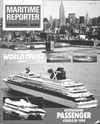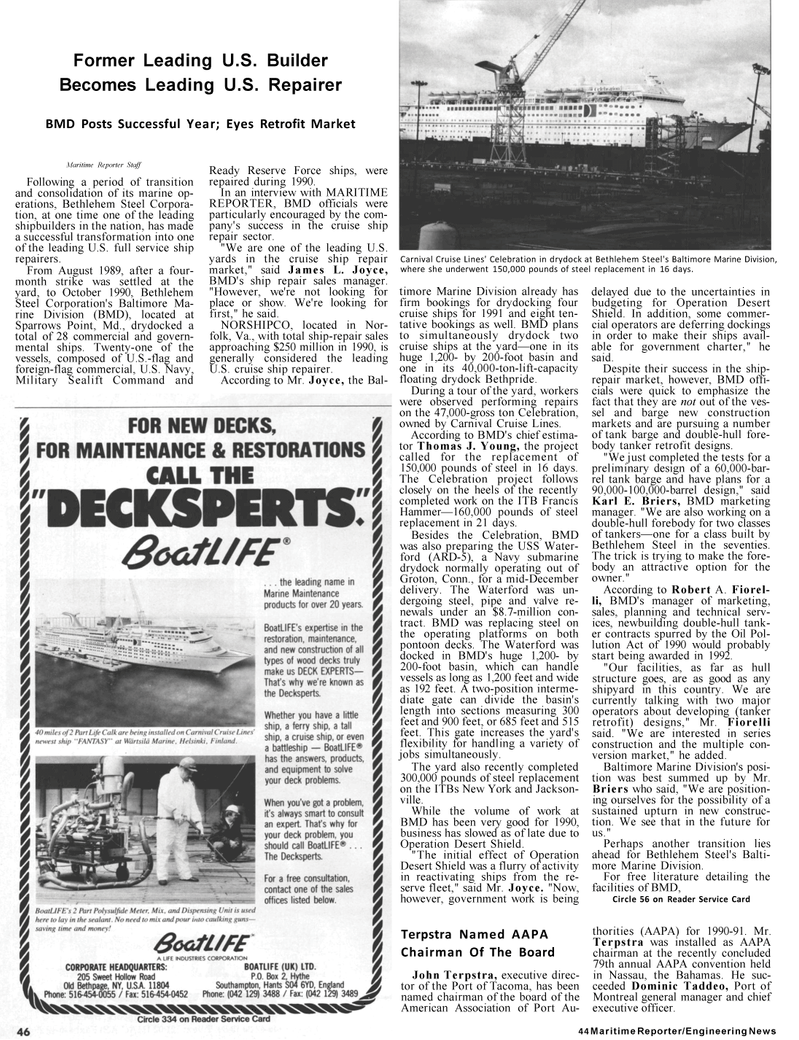
Page 42: of Maritime Reporter Magazine (January 1991)
Read this page in Pdf, Flash or Html5 edition of January 1991 Maritime Reporter Magazine
Former Leading U.S. Builder
Becomes Leading U.S. Repairer
BMD Posts Successful Year; Eyes Retrofit Market
Maritime Reporter Staff
Following a period of transition and consolidation of its marine op- erations, Bethlehem Steel Corpora- tion, at one time one of the leading shipbuilders in the nation, has made a successful transformation into one of the leading U.S. full service ship repairers.
From August 1989, after a four- month strike was settled at the yard, to October 1990, Bethlehem
Steel Corporation's Baltimore Ma- rine Division (BMD), located at
Sparrows Point, Md., drydocked a total of 28 commercial and govern- mental ships. Twenty-one of the vessels, composed of U.S.-flag and foreign-flag commercial, U.S. Navy,
Military Sealift Command and
Ready Reserve Force ships, were repaired during 1990.
In an interview with MARITIME
REPORTER, BMD officials were particularly encouraged by the com- pany's success in the cruise ship repair sector. "We are one of the leading U.S. yards in the cruise ship repair market," said James L. Joyce,
BMD's ship repair sales manager. "However, we're not looking for place or show. We're looking for first," he said.
NORSHIPCO, located in Nor- folk, Va., with total ship-repair sales approaching $250 million in 1990, is generally considered the leading
U.S. cruise ship repairer.
According to Mr. Joyce, the Bal-
Carnival Cruise Lines' Celebration in drydock at Bethlehem Steel's Baltimore Marine Division, where she underwent 150,000 pounds of steel replacement in 16 days. timore Marine Division already has firm bookings for drydocking four cruise ships for 1991 and eight ten- tative bookings as well. BMD plans to simultaneously drydock two cruise ships at the yard—one in its huge 1,200- by 200-foot basin and one in its 40,000-ton-lift-capacity floating drydock Bethpride.
During a tour of the yard, workers were observed performing repairs on the 47,000-gross ton Celebration, owned by Carnival Cruise Lines.
According to BMD's chief estima- tor Thomas J. Young, the project called for the replacement of 150,000 pounds of steel in 16 days.
The Celebration project follows closely on the heels of the recently completed work on the ITB Francis
Hammer—160,000 pounds of steel replacement in 21 days.
Besides the Celebration, BMD was also preparing the USS Water- ford (ARD-5), a Navy submarine drydock normally operating out of
Groton, Conn., for a mid-December delivery. The Waterford was un- dergoing steel, pipe and valve re- newals under an $8.7-million con- tract. BMD was replacing steel on the operating platforms on both pontoon decks. The Waterford was docked in BMD's huge 1,200- by 200-foot basin, which can handle vessels as long as 1,200 feet and wide as 192 feet. A two-position interme- diate gate can divide the basin's length into sections measuring 300 feet and 900 feet, or 685 feet and 515 feet. This gate increases the yard's flexibility for handling a variety of jobs simultaneously.
The yard also recently completed 300,000 pounds of steel replacement on the ITBs New York and Jackson- ville.
While the volume of work at
BMD has been very good for 1990, business has slowed as of late due to
Operation Desert Shield. "The initial effect of Operation
Desert Shield was a flurry of activity in reactivating ships from the re- serve fleet," said Mr. Joyce. "Now, however, government work is being delayed due to the uncertainties in budgeting for Operation Desert
Shield. In addition, some commer- cial operators are deferring dockings in order to make their ships avail- able for government charter," he said.
Despite their success in the ship- repair market, however, BMD offi- cials were quick to emphasize the fact that they are not out of the ves- sel and barge new construction markets and are pursuing a number of tank barge and double-hull fore- body tanker retrofit designs. "We just completed the tests for a preliminary design of a 60,000-bar- rel tank barge and have plans for a 90,000-100,000-barrel design," said
Karl E. Briers, BMD marketing manager. "We are also working on a double-hull forebody for two classes of tankers—one for a class built by
Bethlehem Steel in the seventies.
The trick is trying to make the fore- body an attractive option for the owner."
According to Robert A. Fiorel- li, BMD's manager of marketing, sales, planning and technical serv- ices, newbuilding double-hull tank- er contracts spurred by the Oil Pol- lution Act of 1990 would probably start being awarded in 1992. "Our facilities, as far as hull structure goes, are as good as any shipyard in this country. We are currently talking with two major operators about developing (tanker retrofit) designs," Mr. Fiorelli said. "We are interested in series construction and the multiple con- version market," he added.
Baltimore Marine Division's posi- tion was best summed up by Mr.
Briers who said, "We are position- ing ourselves for the possibility of a sustained upturn in new construc- tion. We see that in the future for us."
Perhaps another transition lies ahead for Bethlehem Steel's Balti- more Marine Division.
For free literature detailing the facilities of BMD,
Circle 56 on Reader Service Card
Terpstra Named AAPA
Chairman Of The Board
John Terpstra, executive direc- tor of the Port of Tacoma, has been named chairman of the board of the
American Association of Port Au- thorities (AAPA) for 1990-91. Mr.
Terpstra was installed as AAPA chairman at the recently concluded 79th annual AAPA convention held in Nassau, the Bahamas. He suc- ceeded Dominic Taddeo, Port of
Montreal general manager and chief executive officer. 44 Maritime Reporter/Engineering News

 41
41

 43
43
